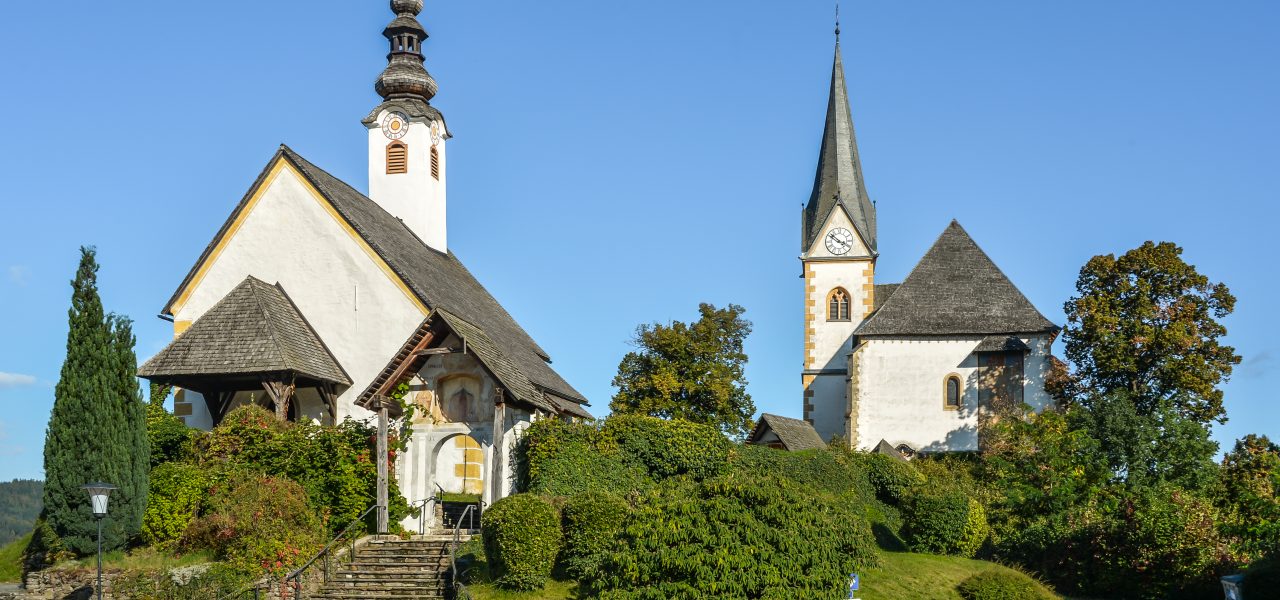INTRODUCTION
The Maria Wörth church complex consists of the parish and former collegiate church, the smaller winter church, a Romanesque church, the cemeteries and the three churchyard portals. Until a connection between the church island and the mainland in 1770, it stood on a peninsula on lake Wörthersee.
HISTORY
The place “Uweride” came into the possession of the Diocese of Freising between 875 and 883. A parish and a mission centre for Carinthia were created here as part of the Slavic mission of the Innichen monastery. A church mentioned for the first time in 894 was built under Bishop Waldo von Freising. The relics of the church patrons Primus and Felicianus from Rome were transferred at an unknown time. Around 1146, Bishop Otto von Freising founded a collegiate foundation with a provost and five, later six, canonical reasons. This could have been the reason for the new construction of the church, which was consecrated in 1155. In 1399, a severe fire damaged the church. After Maria Wörth sank to a sinecure, a benefice without official business, Emperor Maximilian I handed the church over to the Order of St. George in Millstatt in 1529. In 1598 it was taken over by the Graz Jesuits. With the handover to the Jesuit order, the second oldest provost in Carinthia ceased to exist because the Jesuits knew no such facilities. When Pope Clement XIV banned the Jesuit order in 1773, Maria Wörth became a secular parish, which was placed under the patronage of the Benedictines of St. Paul in 1808. An exterior restoration was carried out in 1973, and the late Gothic architectural polychrome was restored in 1991.
ARCHITECTURE AND FURNITURE
The winter or rosary church is located a little lower west of the parish church. It is probably St. Mary’s Church, consecrated by Bishop Roman von Gurk in 1155. It got the name “Winter Church” because the anniversaries of the saints who were worshipped in it fell in winter. The small, originally flat-roofed choir square church was decorated with a cross vault at the beginning of the 16th century. The wall paintings in the choir square from the fourth quarter of the 12th century were uncovered in 1895 and restored in 1969. They show a throne Pantocrator in a mandorla and twelve apostles in turret-crowned arcades with a wide palmette ornament band and curtain base. In the course of the restoration, further frescoes were uncovered on the north wall of the ship and the north triumphal arch wall. These frescoes, painted in the second quarter of the 14th century, are saints with ornamental base strips and the remains of an inscription, as well as a crucifix with a branch cross in the window reveal. The glass painting in the choir window with a Maria and child was made around 1420/1430, the ogival windows in 1898.
After the restoration in 1996, three altars from the 17th century were put up on the north side. They consist of columns or pilasters of the same type with arch gables and differently shaped and framed top pictures. A portal with the number 1687 and a covered staircase leads to the parish church. On the portal with stone walls, a Madonna and Child and Saints Primus and Felicianus are depicted in three painted niches. Two round-arched portals lead to the winter church with shingled gable roofs and each with a niche in the gable wall.
OPENING HOURS
Rosary and Winter Church
April – September
8am – 6pm
October – March
9am – 5pm
On worship hours and by appointment.
CONTACT
Römisch-katholische Pfarrpfründe in Maria Wörth
Pfarrplatz 1
9082 Maria Wörth
Austria


